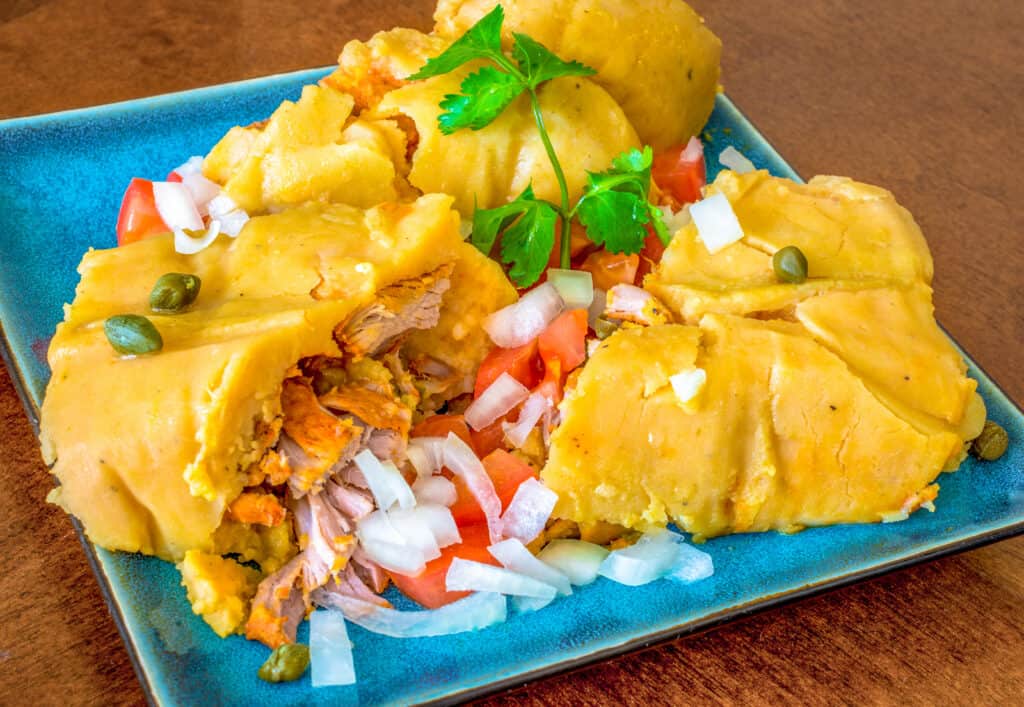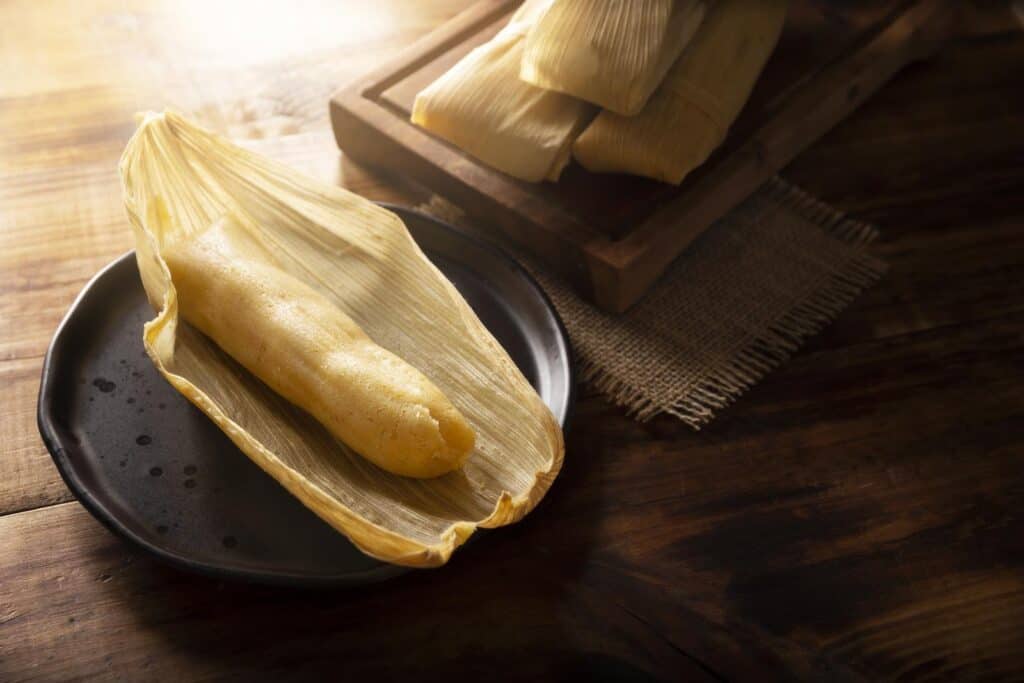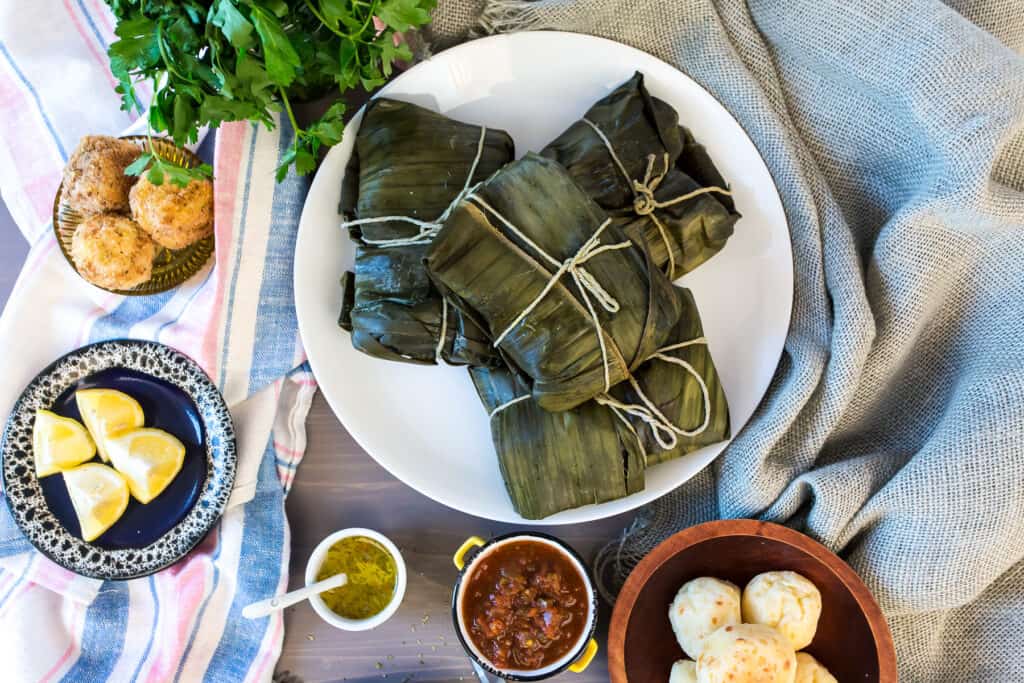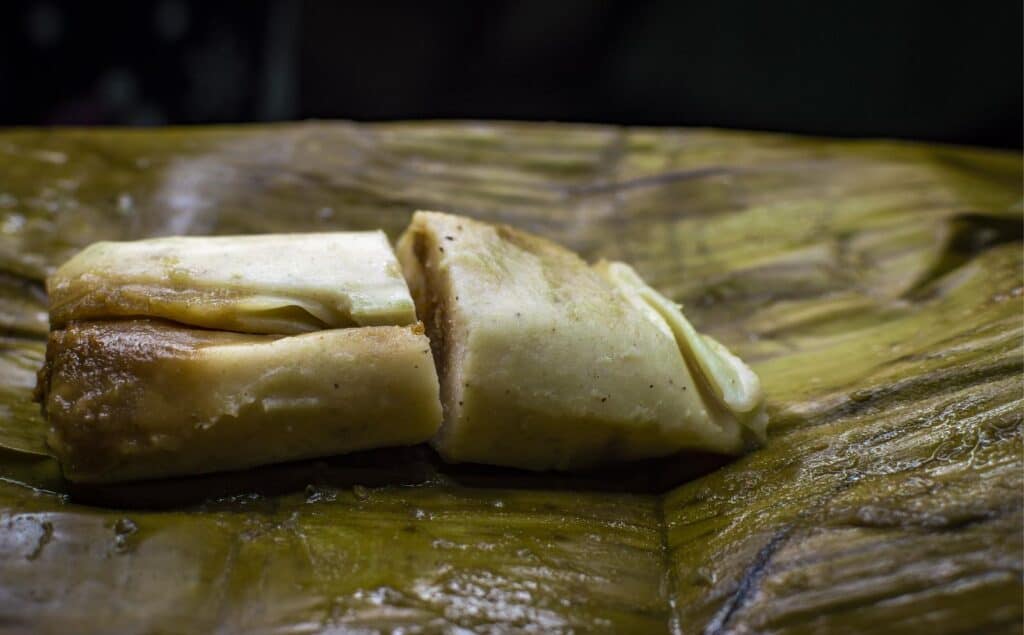Tamales have been a beloved staple of Latin American cuisine for centuries. This article will take you on a journey through the history of tamales, exploring their origins and regional variations across Mexico, Colombia, Honduras, Guatemala and El Salvador.

What are tamales?
A tamal is a traditional Latin American dish made from masa, a type of corn dough and filled with meat, vegetables or even sweets. The filling is typically prepared beforehand and then wrapped in the masa, which is then wrapped in a corn husk or banana leaf, depending on the region. The wrapped tamales are then steamed and served hot. The husk or leaf is not meant to be eaten but rather used as a protective layer during cooking.
Tamales are a staple in many Latin American cultures and have been enjoyed for centuries. Making tamales is often a labor-intensive process in which the entire family or even several families, takes part, as each tamale must be individually assembled and wrapped. However, the time and effort put into making tamales are worth it. They make a delicious and satisfying meal that people of all ages and backgrounds can enjoy.
When to serve tamales
Tamales are typically served during special occasions and holiday celebrations in Mexico and other Latin American countries. They are often served for Christmas, New Year’s Eve and Dia de los Muertos, as well as other special occasions like birthdays and weddings.
In many families, the tradition of making tamales is passed down from generation to generation, with large groups of friends and family coming together days or even a week or two before the holiday, to create the dish and share in the festivities.
Tamales are also a common street food throughout Latin America, sold by street vendors and at festivals, where they are enjoyed by locals and visitors alike.

Wrapping and steaming tamales
Wrapping and steaming tamales is an important part of the tamale-making process.
To prepare Mexican tamales, dried corn husks are used as a wrapper. Before using them, they need to be soaked in water to make them pliable.
Across Latin America, most people prefer to use plantain leaves or banana leaves to wrap their tamales. They give a unique flavor to the tamales and are especially common in South America. Banana leaves are usually burnt over a fire or a gas stove to make them more pliable.
The filling is then added to the masa spread out on the wrapper. After the filling is added, the tamales are rolled up and folded.
They are then placed in a steamer and cooked until they are ready. Steam is an essential part of the cooking process as it cooks the masa and filling evenly. The result is a delicious and comforting dish that can be enjoyed alone or with other traditional Latin dishes.
Filled with appetizers, salads, sides, mains and desserts, Food Drink Life's cookbook will become your favorite!
- Easy and delicious recipes from a variety of top chefs and recipe developers.
- Bright, colorful pictures on every page.
- Printer-friendly recipes that you can download instantly to your device.
- Printable shopping list and a kitchen conversion sheet.
Mexican tamales
Mexican tamales were first invented in pre-Columbian times and originated from the indigenous people of Mesoamerica. Today, they are one of the most treasured dishes of traditional Mexican cuisine.
Mexican tamales are unique in their corn husk wrapping. They comprise a dough made from masa harina and lard, which is spread on a dried corn husk. The tamale filling is then added on top, typically including meat, onions and spices like cumin. The husk is then wrapped around the filling and tied with string before being steamed.
While steaming, the corn husk helps the tamale keep its shape and prevents it from sticking to the steamer. Mexican tamales can be served with broth or made with a moist texture by simmering the tamales in the water used to make the broth.

Colombian tamales
Colombian tamales, known as “tamales tolimenses,” have a distinct identity and flavor. They trace their roots back to the indigenous people who used to prepare them as their traditional Colombian food for special occasions and celebrations.
These tamales are made with a mixture of yellow cornmeal, chicken or pork and a variety of vegetables and spices. The filling is wrapped in a banana leaf and steamed to perfection.What sets Colombian tamales apart is the addition of achiote oil, which gives them their vibrant orange color and unique taste. Topped with aji sauce, these tamales offer a burst of flavors that is both comforting and satisfying.
Honduran tamales
Honduran tamales, known as “tamales catrachos” or “tamales hondureños,” are a beloved dish in Honduran cuisine. They have a rich history influenced by the indigenous Lenca people, Spanish colonizers and African slaves.
Honduran tamales are made with a corn-based dough, seasoned with annatto oil and filled with a mixture of seasoned meats, olives, raisins and sometimes vegetables. The filling is wrapped in banana leaves and steamed.
These tamales have a unique combination of sweet and savory flavors that make them a popular choice for breakfast or special occasions.
Guatemalan tamales
In Guatemala, tamales play a central role in culinary traditions and celebrations. Guatemalan tamales, known as “tamales guatemaltecos,” are a labor of love, often prepared for Christmas and other festive occasions.
These tamales are made with a corn masa dough that is seasoned with a variety of spices and enriched with chicken broth or lard. The filling usually consists of meats such as chicken or pork, along with vegetables, olives, capers and achiote.
Guatemalan tamales are wrapped in banana leaves and steamed to perfection. They are known for their generous size.

Salvadorian tamales
Salvadorian tamales, known as “tamales salvadoreños,” are a popular dish in El Salvador. They have a unique twist that sets them apart from tamales in other regions. Salvadorian tamales are made with a thicker corn masa dough that is mixed with chicken broth and lard, giving them a rich and dense texture.
The filling usually consists of seasoned meats such as chicken, pork or beef, along with vegetables, olives and raisins. These tamales are wrapped in plantain or banana leaves and steamed until the masa becomes tender and infused with flavors.
Served with a side of curtido (a pickled cabbage slaw) and salsa, Salvadorian tamales offer a harmonious blend of flavors and textures.
What to serve with tamales
Although tamales are a meal on their own, they are often complemented with a variety of side dishes.
In Colombia, tamales are often served with aji (spicy salsa) or plantain chips.
In El Salvador and Honduras, a pickled cabbage salad called “curtido” and pico de gallo salsa are the most popular accompaniments.
Guatemalan tamales are usually served with black beans and rice.
In Mexico, tamales are often served with a side of refried beans, sliced avocado and a salsa made with tomatillos and chile peppers.
Regardless of the country, Latin tamales are best paired with a refreshing drink like horchata or jamaica, which helps to balance the richness of the dish.

Wrapping up
Tamales have a fascinating history deeply intertwined with the cultures and traditions of Latin America. They have evolved from an indigenous dish to a modern, vibrant plate, reflecting the influences of indigenous ingredients, colonial legacies and the creativity of local communities.
Whether you’re enjoying Colombian tamales with their vibrant color, savoring the sweet and savory combination of Honduran tamales, exploring the rich flavors of Guatemalan tamales or indulging in the dense and hearty Salvadorian tamales, each bite tells a story of heritage and culinary excellence.
So, next time you unwrap a tamale, take a moment to appreciate the centuries of tradition and craftsmanship that have gone into creating this mouthwatering wrapped parcel.
